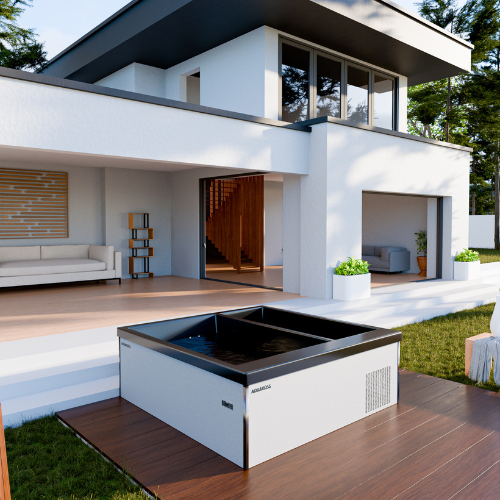Imagine feeling refreshed and invigorated without ever leaving the comfort of your home. That’s what contrast therapy offers you—a simple, yet powerful, way to rejuvenate your body and mind.
You might be wondering how something so effective can be so accessible. Well, you’re in the right place to find out. In this guide, we’ll walk you through everything you need to know about performing contrast therapy at home. You’ll discover how this technique can enhance your well-being, boost circulation, and even elevate your mood.
Ready to unlock the secrets of this age-old practice? Let’s dive into the steps that will transform your everyday routine into a revitalizing experience.
What Is Contrast Therapy?
Contrast therapy is a method using hot and cold water. It helps your body recover and feel better. You can do this at home. It is simple and does not need special tools. Hot water makes blood flow faster. Cold water slows it down. This switch makes muscles relax and recover. It is like a gentle massage for your body.
People feel less pain after using it. It is good for sore muscles. Athletes use it often. It helps them after playing sports. You can do it too. Just be careful with water temperature. Do not use water that is too hot or too cold.

Benefits Of Contrast Therapy
Contrast therapy helps reduce muscle pain. It uses hot and cold water. This therapy boosts blood circulation. Blood moves faster, bringing nutrients. It helps muscles recover. Contrast therapy can lower inflammation. Cold water reduces swelling. Hot water relaxes muscles. This therapy can also improve flexibility. Muscles feel loose and relaxed. Contrast therapy is easy to try at home. Use a shower or tubs. Switch between hot and cold water. Be careful with water temperature. Don’t use very hot water. Start with warm water first. Then switch to cold water. Repeat several times. Feel the benefits over time.
Choosing The Right Equipment
Contrast therapy needs a few basic tools. Hot water and cold water are key. You need a bath or buckets for the water. A thermometer helps check the water temperature. Towels are needed to dry off. These items make the therapy easy and safe.
Some people like to use essential oils. These can add a nice smell. Epsom salts may be added to the hot water. They help relax the muscles. Ice packs can be used for cold therapy. A timer helps keep track of the time. These accessories are not required but can make the experience better.
Preparing Your Space
Safety is very important. Make sure the floor is dry to prevent slips. Check the water temperature before starting. It should not be too hot or too cold. Have a towel nearby to dry yourself quickly. Keep electrical devices far from water areas. Always listen to your body. Stop if you feel dizzy or uncomfortable.
Your space should feel calm and relaxing. Ensure the room is quiet and free from distractions. Soft lighting can help you feel more at ease. Use a bath mat to keep feet warm and comfortable. Consider playing gentle music to enhance relaxation. You may also want to light a scented candle for a pleasant aroma. A comfortable chair or stool can be useful for resting between sessions.
Step-by-step Guide
First, you need to prepare two areas. One for hot and one for cold. Use a large bowl or tub for each. Fill one with warm water. The water should be comfortable, not too hot. For the cold station, fill with cool water. Add some ice if you can handle it. Check the temperature with a thermometer. Safety comes first. Make sure everything is stable. Place towels nearby to dry yourself. This helps avoid slipping. Now, you’re ready to start.
Switch between hot and cold every few minutes. Begin with hot water. Stay for three minutes. Then move to the cold station. Stay there for one minute. Repeat the cycle three to five times. Total time should be around 15 minutes. It’s normal to feel a bit of shock. Your body will adjust. Stay relaxed. Breathe deeply through the cycles. Stop if you feel uncomfortable. Remember, everyone is different.

Best Practices
Start with short sessions. Five minutes each for hot and cold. Use a timer to keep track. Listen to your body. Stop if you feel dizzy or uncomfortable. Gradually increase time as you get used to it. Keep water nearby. Stay hydrated during the therapy. Choose comfortable clothing that’s easy to remove. Have a towel ready to dry off after cold water. Ensure safe and easy access to both hot and cold water. Safety first.
Avoid staying in hot water too long. It can cause burns. Don’t ignore discomfort. Stop if you feel pain. Skipping cold water reduces benefits. Do both for best results. Rushing between hot and cold can cause shock. Keep intervals smooth and steady. Not paying attention to temperature changes can be risky. Always check water temperature before starting. Overdoing it can tire your body. Keep sessions moderate.
Integrating Into Daily Routine
Contrast therapy can be part of your daily life. Try it three to five times each week. This helps the body recover and relax. It is important to keep it regular for best results. Sessions can be short, lasting only 10-15 minutes. This makes it easy to fit into busy schedules.
Frequency Recommendations
Some experts suggest alternating hot and cold every day. Others recommend every other day. Listen to your body and find what works best. It is okay to adjust based on how you feel. Start slow and gradually increase frequency. This allows the body to adapt and benefit.
Combining With Other Therapies
Contrast therapy can be combined with other treatments. Massage therapy complements it well. Yoga or stretching can enhance relaxation. Make sure to hydrate and rest after sessions. This helps the body recover and reduces fatigue. A balanced approach leads to better health.

Understanding Your Body’s Response
Keep track of how your body feels during contrast therapy. Make a note of any changes in your mood or energy. It helps to use a journal. Write down your feelings before and after each session. Check if muscles feel more relaxed or if stress is less. This helps you see what works best for your body.
Sometimes you need to change your methods. If one method is too intense, try something gentler. Maybe you can shorten the hot or cold times. Or use a different temperature. It’s important to listen to what your body says. This makes therapy more effective and safe.
Frequently Asked Questions
How To Do Contrast Therapy At Home?
Fill one tub with cold water and another with warm water. Immerse the body part in warm water for 3 minutes, then switch to cold water for 1 minute. Repeat the cycle for 15-20 minutes. Always end with cold water.
Consult a doctor if you have health concerns.
Can You Overdo Contrast Therapy?
Yes, overdoing contrast therapy can lead to adverse effects. Limit sessions to 20 minutes. Monitor your body’s reactions carefully. Consult a healthcare professional for personalized advice. Balance cold and hot exposure to avoid skin irritation or circulatory issues. Ensure your sessions are safe and effective for optimal results.
What Are The Rules For Contrast Therapy?
Contrast therapy involves alternating hot and cold treatments. Start with hot for 3-4 minutes, then cold for 1 minute. Repeat this cycle 3-5 times. Always end with cold to enhance recovery. Ensure water temperatures are comfortable and safe to avoid burns or frostbite.
Consult a professional for personalized advice.
How To Take A Contrast Shower Correctly?
Start with warm water for 3 minutes. Switch to cold water for 30 seconds. Repeat the cycle 3 times. End with cold water. Gradually increase the temperature difference for better results.
Conclusion
Contrast therapy offers great benefits. It improves circulation and reduces muscle pain. You can easily practice it at home. All you need is hot and cold water. Always start with warm, then switch to cold. Listen to your body. Stop if you feel discomfort.
Regular sessions can boost your recovery. They also enhance relaxation. Be consistent for best results. Try different routines to find what works. Stay hydrated for optimal effects. Contrast therapy is a simple, effective method. Enjoy the soothing relief it brings.
Your body will thank you.
Read More:
- Strength Training Program for Beginners 2025: Start Strong
- Kettlebell Workout Plan for Fat Loss: Transform Your Body
- Home Power Rack Buying Guide USA: Top Picks & Tips
- Best Protein Timing for Strength Athletes: Maximize Gains
- Barbell Vs Dumbbell Strength Benefits: Maximize Gains
- Daily Mobility Routine for Desk Workers: Boost Your Health
- Cryotherapy Benefits And Pricing USA: Maximize Wellness
- Intermittent Fasting Tips for Active Adults: Boost Energy